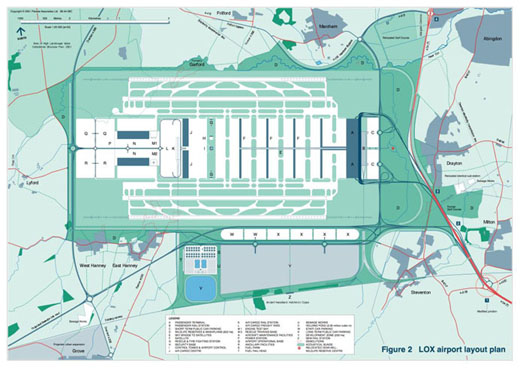- Site navigation:
- Pleiade Associates · Home
- Projects
- LOX Study (2013)
- PREVIOUS LOX Study (2003)
- About us...
- On The Pleiades...
- contact us
- Site map
![]()
A single option is advanced for a four runway airport with two pairs of close parallel runways. The annual capacity would be 120 million passengers and 4 million tonnes of air cargo. The initial phase of passenger Terminals would provide an annual capacity of 60 million passengers, with the anticipated further phases in 2021 and 2024 giving a combined capacity of 90 and 120 millions respectively.
Runways would be provided to match demand, in two phases each of two runways. Applying a utilisation limit of 80 per cent for the use of the airport runway system, all four runways would not be required until about 2024.
Although the demand forecast for the airport shows a need for two Terminals, each serving 30 million passengers, and two runways from the opening date, the design allows for construction of a single Terminal and runway should demand not match the projected levels.
There are no major 'front end' capital costs entailed in the development of the airport. The comparatively low costs of the initial phases and the ability to ensure that growth could be closely and economically matched to demand would significantly reduce the risk that the project would require Public Sector financial support.
The airport Master Plan layout in the context of the nearby settlements is shown on Figure 2.

The airport development costs are estimated at about £11.2 billion (based on Quarter 1 2002 prices). A Pre-feasibility estimate of costs, including those for infrastructure and a Development Zone, is included in an associated report.
Download a pdf version (size 92K) of the Cost report.
Forecasts of passenger demand at the airport is based on the Department for Transport forecasts to 2030. [note 2]
In order to demonstrate a 25 year project operational period the demand is projected to 2040 on the basis of a long-term trend that assumes market stability for air transport in about 2050-2060.
| Option | Year | Passengers (mppa) |
ATM* ('000) |
|
|---|---|---|---|---|
2 runways |
2015 |
Capacity |
60 |
513 |
|
|
Demand |
35 |
250 |
2 runways |
2020 |
Capacity |
90 |
513 |
|
|
Demand |
50 |
338 |
4 runways |
2030 |
Capacity |
120 |
756 |
|
|
Demand |
98 |
606 |
4 runways |
2040 |
Capacity |
120 |
756 |
|
|
Demand |
120 |
719 |
* Air Transport Movements, including Cargo ATM's
The forecast of air cargo demand at the airport is [see Appendix Figures A.1-A.9]:
| Option | Year | Air Cargo (million tonnes) |
ATM ('000) |
|
|---|---|---|---|---|
2 runways |
2015 |
Capacity |
1.0 |
25 |
|
|
Demand |
0.9 |
12 |
2 runways |
2020 |
Capacity |
2.0 |
25 |
|
|
Demand |
1.4 |
18 |
4 runways |
2030 |
Capacity |
3.0 |
50 |
|
|
Demand |
2.9 |
33 |
4 runways |
2040 |
Capacity |
4.0 |
50 |
|
|
Demand |
4.0 |
44 |
Air Traffic Forecasts for the United Kingdom 2000. Department for Transport. London, 2000.
Return |
❖ The LOX Report (2003) is freely available as PDF documents here.
Note:
The former links to these documents are 'dead'. Both were available online on government websites, but the tiresome habit of the British Civil Service of 'burying' information seems to have endured into the age of the internet. The former link to Review of London Oxford Airport (PDF document), Halcrow (2003), if followed beyond the re-direct page, yields a looped link—misleading re-titled as The Future of Air Transport - White Paper and the Civil Aviation Bill. Thus the supposedly archived documents are effectively hidden: hence we provide them through the above links to our archive copies of the originals. [Unsuprisingly] all references to LOX have disappeared from .gov.uk sites.